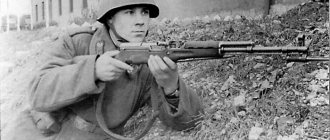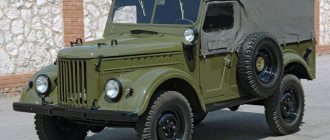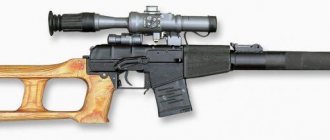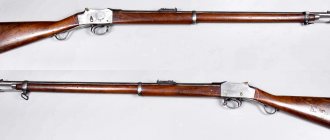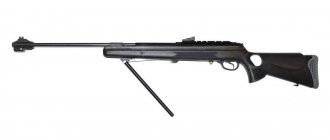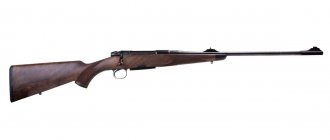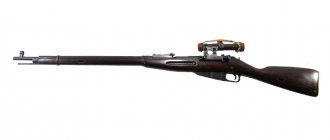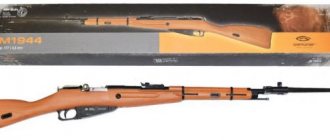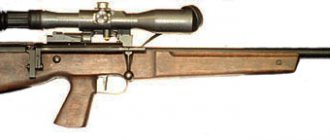The second half of the 19th century was marked by a surge in technological progress. New opportunities in the implementation of technical solutions and the transition to mass production have significantly expanded the field for creating a new type of repeating rifle. The most important role in this was played by the emergence of smokeless gunpowder. Reducing the caliber without reducing the power of the weapon opened up a number of prospects in terms of improving the mechanisms of the weapon. One of the results of such work in Russia was the Mosin rifle (pictured below) of the 1891 model.
A few words about history
The introduction of the first repeating rifles into service with the French army in 1886 raised the question of replacing outdated weapons in the Russian army. The Commission for Testing Repeating Shotguns, created in 1883 in Russia, examined more than 150 variants of rifles, both foreign and Russian designers. The factor hindering the decision to introduce magazine weapons was a skeptical attitude towards the rate of fire, in which senior military officials saw the danger of unnecessary waste of ammunition.
The first drawings of the Mosin rifle appeared on the basis of a four-line version with a butt magazine. The four-line Berdan rifle, which was in service with the tsarist army at the end of the 19th century, no longer corresponded to the realities of the time and had a significant number of shortcomings. In 1882, S.I. Mosin began work on its modernization.
Mosin rifle mod. 1891 is a repeating rifle with a caliber of 7.62 mm. It is equipped with a sliding bolt that locks with a twist. The range is about 1000 meters. Mosin rifle model 1891-1930. The following tactical and technical characteristics are inherent:
- its caliber is 7.62 mm;
- rifle length with bayonet – 166 cm;
- without cartridges and a bayonet, its weight is 4.5 kg;
- a fully equipped clip weighs about 130 grams;
- Magazine capacity - 5 rounds, cartridges are removed mechanically.
The history of the appearance and creation of the legendary three-line
In 1882, the task was set to develop a new rifle for the army of the Russian Empire. A year later, a special testing commission was created, whose task was to select and test various samples in order to choose the most suitable model for the army. Major General Chagin was appointed chairman of this commission.
After lengthy and thorough tests of various systems and types of weapons, which were carried out for entire years (for 6 years), by 1889, two systems were selected that had proven themselves to be the best:
- Domestic system developed by Captain Mosin;
- Belgian Nagant system.
Field tests of the weapon showed that the design of the Belgian rifle is significantly superior to the Mosin model. All officers and soldiers who participated in the tests chose the Belgian model.
The members of the testing commission, in turn, unanimously voted for the Mosin rifle, which was much cheaper, simpler and had half as many misfires. As a result of the debate, which lasted for another 2 years, in 1891 the updated Mosin rifle, which was equipped with a 5-round magazine developed by Nagan, was adopted by the Russian army.
Although the new rifle is now known as the Mosin carbine or Mosin sniper rifle, the system was actually called the Mosin-Nagant. This name was established as a result of an agreement with the Nagan brothers, who allowed the use of a store of their design only if such a name was used.
They decided not to award the authorship of the new rifle to anyone, since the new model contained parts and circuits developed by different gunsmith designers:
- Captain Mosin;
- Colonel Rogovtsev;
- The selection committee headed by Chagin;
- Belgian gunsmith Nagan.
As a result, the new model was called the “Russian three-line rifle of the 1891 model.” On April 16, 1891, the new rifle was put into service under the name “three-line rifle of the 1891 model”, since Emperor Alexander III crossed out the word “Russian” in the name.
Mosin received the rights to authorship of the rifle parts he developed. In addition, he received the Grand Mikhailovsky Prize.
Naturally, ordinary soldiers did not call the new “gun” by such a long name. The rifle began to be called the “three-ruler”, and the name “Mosin rifle” was returned to it only in 1930, when it was modernized. In Europe, the Russian rifle has always been called the Mosin-Nagant system.
The first years of operation of the “three-line” showed some minor flaws in its system. As a result, the design underwent upgrades that corrected these shortcomings:
- In 1893, wooden pads appeared that protected the soldier’s hands from burns;
- In 1896 the old ramrod was replaced. The new one has become longer, and its head has increased in diameter, which simplifies the cleaning process;
- The notch on the side covers of the magazine box was removed, as it wiped the mold.
These improvements were introduced not only into new batches of rifles, but also into the design of previously released weapons. The production of “three-line guns” was carried out at an accelerated pace, so by the beginning of the Russo-Japanese War, the Russian tsarist army had more than 3,800,000 rifles of this system in service.
After the development and adoption of a new cartridge equipped with a pointed bullet, in 1910 the “three-line” began to be produced in a new version, which was equipped with a sight of the Konovalov system, which was better suited to the ballistic properties of the new ammunition.
Upgrade options
Throughout its entire service - which is about 120 years - the rifle underwent only some minor upgrades, which were aimed at ease of use and low cost of production.
In addition to the “standard” infantry rifles, dragoon and Cossack rifles were soon adopted, and a little later a carbine. The 1944 model carbine had a fixed folding bayonet, the designer of which was Semin. The shooting of such guns was carried out with the bayonet brought into the firing position.
There are few changes as such that have happened to the rifle over the years. They were mainly aimed at simplifying production, as well as reducing costs. Thus, the sighting bar was improved and the design of the receiver was changed.
Tuning the “three-line” from ProMag
Tuning of the Mosin rifle is most widespread in the USA. About 10 years ago, rifles became available for purchase by civilians, as the design of rifles was obsolete for the needs of the army, and also due to the need to free up space in weapons depots.
It should be noted that the Mosin rifle in the USA is sold at a fairly affordable price and is in great demand among American shooters. Tuning of the Mosin rifle is varied - from handicraft fakes to factory products from foreign companies such as ProMag or Timney. Even the standard rifle magazine has been improved. ProMag has released a ten-place version of the polyamide magazine chambered for 7.62 x 54 R, designed for use with the ProMag Archangel stock.
The ProMag Archangel AA9130 orthopedic stock is made of carbon and polymer. In fact, this stock made of reinforced plastic is completely devoid of the problems of its wooden counterpart. Plastic is not afraid of moisture and, as a result, it is not at risk of geometry violations. The ability to adjust the butt plate and cheek height in a fairly wide range allows you to customize the rifle for individual use.
The Good
Do you think investing $300 worth of tuning into a rifle you bought for 99 bucks is stupid? How to say. Americans, for example, willingly change old Mosin-Nagants into new fashionable plastic stocks “Archangel OPFOR Stock”.
The result is a more comfortable rifle with a detachable five- or ten-round magazine, an adjustable stock and a modern appearance.
Yes, sometimes you need a little peeling in the process, but this also has its own thrill.
And if you want something a little less “tactical”, but no less useful, you can look at the tuning from the Russian (Sureshot Armament Group), which includes an elegant “hunting” stock made of laminate or polymer composite, bedding, modification of the trigger and bolt .
The modification to the bolt and receiver is quite significant - the bolt handle was moved back, closer to the trigger. A rear bridge was made on the receiver, onto which a Picatinny rail for optics is attached.
The magazine box was shortened to three rounds; it no longer protrudes from the stock; At the same time, the ability to load the rifle from clips was lost. The result is a very decent rifle chambered for an affordable and effective cartridge for hunting a wide variety of game.
Even if it's not cheap.
Sniper rifle SSG-96
In the 90s, weapons designers from Finland presented the SSG-96 sniper rifle - their version of the modern vision of tuning the Mosin rifle. Until now, this rifle is considered one of the best in the West.
This model is a magazine type, reloading is carried out manually. It has a device that regulates the force of pressing the trigger. Reinforced plastic was used to make the stock, and the cold forging method was used to make the barrel. It is equipped with a six-fold sight with the ability to install night optics.
Mosin rifle for hunting
Although there is no such thing as a Mosin hunting rifle, many modern hunters use rifles of this system for hunting. This weapon has a fairly high accuracy of shots, so it is often used for hunting in ambush. Walking hunting with this rifle is not very popular, since its rate of fire is low and its weight is quite large.
The sniper modification of the Mosin rifle is best suited for hunting, although it is very difficult to get. Many people get out of the situation by welding a longer and curved bolt handle, which does not pose a problem with the modern availability of household welding machines.
The main advantage of the Mosin rifle for hunting is its reliability. The rifle can be dropped in the mud, frozen, drowned, and so on. It will still shoot, although you should not abuse such “experiments”.
The Mosin rifle is the best military rifle of the first half of the 20th century. Its reliability and accuracy are worthy of respect. That is why even now Mosin rifles are used by some professional hunters.
Sniper rifle OTs-48K
In 2000, Russian gunsmiths subjected the Mosin rifle to serious tuning. Having used the newfangled bullpup system and polished the trigger mechanism, they gave the rifle the name “OTs-48K”
OTs-48K are produced by converting sniper variants of the Mosin rifle retrieved from warehouses. The model is still used in some units of the Russian army.
Modern upgrade
One of the latest innovations on the market is tuning the Mosin rifle from.
It manufactures and offers "tri-line" aluminum stocks that fit all rifles, including early hex versions, without requiring additional modifications. Simply replace the old wooden stock with a new aluminum stock. You can see the tuning of the Mosin rifle in the photo below.
One of the interesting features of the stock is that it has standard threads for tube stocks, so it will fit any AR-based rifle stock. As well as a protective coating in Cerakote color.
General rules of operation and storage
Keeping your rifle clean, treating it with care, carefully monitoring for malfunctions and confidence in its combat readiness are the keys to long-lasting and reliable service of the weapon. However, with prolonged use, wear of parts inevitably occurs, as well as contamination of the mechanisms; as a result of this or inappropriate care, the rifle may develop malfunctions that will disrupt its normal operation.
To prevent malfunctions, you must:
- Strictly follow the rules for assembling, disassembling, cleaning, inspecting and storing the rifle.
- During the cold season, use winter lubricant to treat rubbing surfaces.
- Before starting shooting, be sure to inspect the clip and cartridges; dirty or faulty cartridges cannot be loaded.
- While firing, as well as when running and stopping, carefully monitor and protect the rifle from becoming clogged with dirt, dust and sand.
No matter what conditions the shooter is in, he is obliged to keep his rifle clean, handle it with care, and conduct regular inspections to be sure that it is in full service and combat readiness.
In conclusion, it must be said that interest in the Mosin rifle, despite the deeply outdated system, has not weakened over the years. The rifle, as before, performs its functions perfectly.
Advantages and disadvantages of the Mosin rifle
All models of small arms have their advantages and disadvantages. The Mosin rifle also has them. The advantages of this model are as follows:
- Excellent ballistic properties and cartridge power, although at that time most cartridges were equipped with black powder;
- The barrel and bolt were distinguished by their reliability and “survivability”;
- Simple manufacturing technologies and low production costs;
- Overall reliability of the rifle in any conditions;
- Simplicity of the shutter design. It can be disassembled and assembled without using tools;
- The magazine box is closed, and it is practically impossible to damage it accidentally;
- Easy-to-manufacture frame-shaped clip;
- The shutter is easy to remove for cleaning;
- Good rate of fire;
- The shutter cylinder can be replaced in case of breakage, leaving the shutter itself, since the cylinder is a separate part;
- Simple and cheap replacement of wooden rifle parts.
Naturally, the Mosin rifle is not without its drawbacks:
- The use of outdated cartridges equipped with a rim required the use of a cut-off reflector. This part is quite difficult to manufacture and vulnerable. Using a double-row magazine (and rimless cartridges) could help eliminate the need for a deflector cut-off and increase the number of rounds in the magazine to 10 pieces. It is these stores that are used in foreign rifles of the “Lee” system. Unfortunately, during several modernizations, the Mosin rifle was left with an archaic magazine;
- The bolt cylinder lugs are located horizontally, which increases dispersion. If the stops were positioned vertically, this could reduce dispersion;
- The heavy and long trigger of the Mosin rifle significantly interferes with shooting accuracy. Although experienced hunters who have been using rifles of this brand for a long time do not even notice this feature;
- The frame clip, which does not have springs, is quite archaic. Already at the time of the appearance of the Mosin rifle, there were spring clips (the same clip designed by Mosin), which were rejected by the Tsar's testing commission due to the high cost of production;
- The long bayonet, which was mounted on the barrel, made Mosin rifles inconvenient for trench battles;
- All Mosin rifles (except for the Cossack carbine) were sighted together with a bayonet. Removing the bayonet immediately significantly shifted the point of impact. The constant presence of a bayonet made the rifle quite cumbersome;
- The shutter handle was too short, which made opening much more difficult. This design forced the shooter to remove the rifle from his shoulder to reload. The sniper modification of the Mosin rifle was devoid of this drawback. It is worth noting that the prototypes of the Mosin and Nagant rifles had a long and bent bolt handle, but the commission found that the long sleeves of soldiers' greatcoats made it difficult to reload the rifle with such a length of the bolt handle. This is what prompted the return to the same configuration as on the old Berdan rifles;
- The neck of the butt of the Mosin rifle is straight, which was made specifically for bayonet fighting. In modern realities, such a stock is not very convenient for shooting;
- The safety on the Mosin rifle, although simple, is too unreliable. There are often cases of its mowing;
- The wooden parts of the Mosin rifle were never of high quality, and the wood used for them was of rather low grade. If the rifles of the tsarist years of production had better butts and stocks, then the rifles produced during the Great Patriotic War had very mediocre quality wooden parts.
Some design flaws of the Mosin rifle can be eliminated with your own hands. Since many people use Mosin rifles for hunting, “tuning” of Mosin rifles and carbines is now very popular, which most often includes replacing the wooden parts of the rifle and installing high-quality optics.
